Find out how to set boundaries with confidence and create more space for peace, focus, and balance in your daily life. Learn simple strategies that help you protect your time and energy—starting today.
Thank you for reading this post, don't forget to subscribe!High achievers and leaders are known for their drive, reliability, and ability to deliver results under pressure. But that same strength often becomes a silent weight.
You take on more, you help everyone, you solve problems quickly—and suddenly your days fill with urgent requests, endless tasks, and emotional labor no one ever sees.
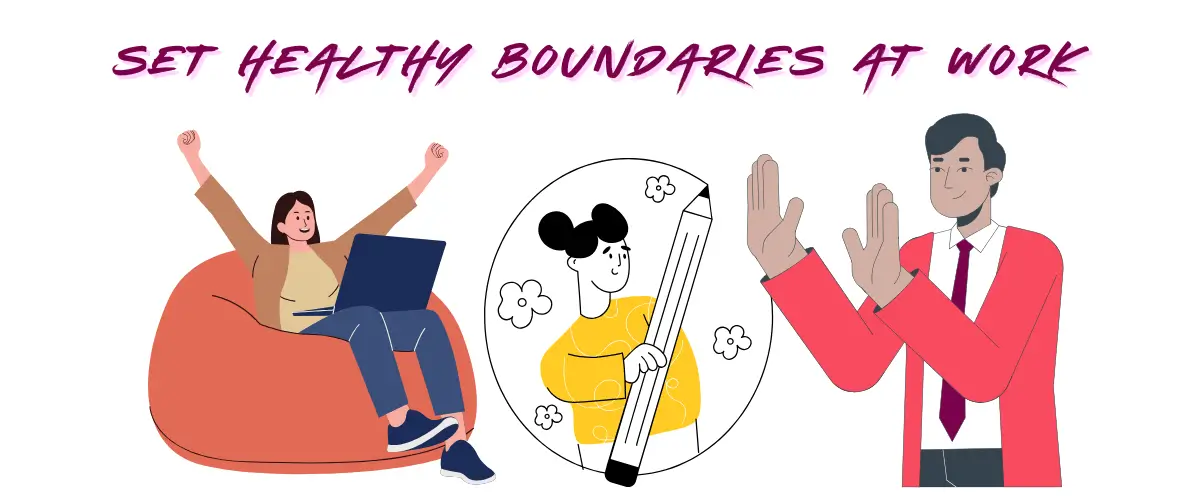
If you’ve ever wondered why being “dependable” sometimes feels draining instead of rewarding, you’re not alone.
The real issue isn’t capability—it’s boundaries. More specifically, the lack of them.
Today, we’re redefining boundaries as not rigid rejection, but rather responsible self-leadership—a skill every high performer needs to sustain long-term success.
Why High Achievers Struggle With Boundaries (Even When They Know Better)
People who excel at work almost always share a cluster of traits that make boundary-setting feel unnatural. These traits aren’t weaknesses—they are strengths that have been stretched beyond their limits.
- You care deeply about your work.
- You want to be dependable and competent.
- You feel uneasy about disappointing others.
- You’ve built an identity around “handling everything.”
- You operate more efficiently and effectively than most teammates.
This combination creates a powerful but dangerous pattern: over-functioning disguised as excellence.
You’re not overworking because you’re weak.
You’re overworking because you’re strong.

The 3 Psychological Patterns Behind Over-Giving
These patterns recur among leaders, entrepreneurs, and top performers. They are learned behaviors—and that means they can be unlearned.
1. The Responsibility Reflex
- You jump in before anyone else moves.
- You’re the first to volunteer.
- You say yes, sometimes before you’ve even processed the request.
It feels heroic, but it leaves you constantly managing other people’s responsibilities as well as your own.
2. The Competence Trap
When you’re great at your job, you become the “safe pair of hands.”
Instead of delegating, people funnel more work to you because you’ll do it well and without complaint. Competence becomes a magnet for more responsibility—until you’re overloaded.
3. The Approval Loop
You worry that saying no might make you look difficult, unhelpful, or less committed. So you over-deliver. And when people praise your reliability, it reinforces the loop.
Approval becomes addictive, and boundaries feel like a threat to your reputation. These patterns don’t reflect weakness—they reflect unmanaged strengths.
The Real Purpose of Boundaries (Hint: It’s Not Protection)
Most people think boundaries are about defending their time, energy, or personal space. But in professional settings, boundaries serve a much bigger purpose.
Healthy boundaries:
- Strengthen communication
- Reduce everyday misunderstandings
- Increase clarity and predictability.
- Improve team coordination and performance.
- Prevent resentment and burnout.
- Build trust and respect without conflict.
Boundaries are not walls—they are instructions for collaboration.
People don’t need you to be endlessly available.
They need you to be clear, consistent, and predictable.
Understanding the Over-Giving Cycle at Work
When you don’t set limits, you unintentionally create a self-feeding loop:
- You say yes too often.
- People expect you to keep saying yes.
- Requests increase because you’ve become the “safe option.”
- Your workload expands beyond capacity.
- You feel resentment, exhaustion, or quiet frustration.
- Guilt pushes you to say yes again, even when you shouldn’t.
Over time, you train others—without realizing it—to rely on you more than necessary.
A unique leadership insight:
When you refuse to set boundaries, you don’t just exhaust yourself—you limit other people’s development.
Others can’t grow if you’re doing the work for them. Setting boundaries is not selfish.
It’s a form of leadership.
5 Foundational Principles for Setting Guilt-Free Boundaries
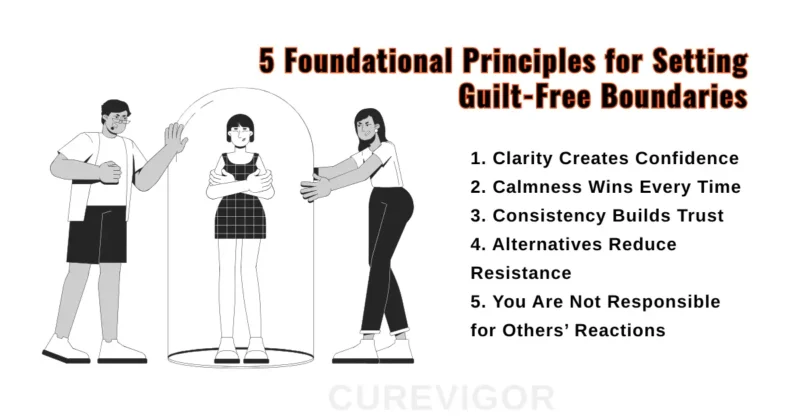
These principles shape boundaries that feel strong, calm, and respectful—without the emotional friction.
1. Clarity Creates Confidence
Ambiguous limits confuse people. Clear ones help them understand how to work with you. People respect rules they can see.
2. Calmness Wins Every Time
- Boundaries delivered in frustration sound like anger.
- Boundaries delivered calmly sound like professionalism.
Your tone—not your words—is what people remember.
3. Consistency Builds Trust
If you say no once but yes the next time, people won’t recognize your limit as real. Consistency turns a boundary into a standard.
4. Alternatives Reduce Resistance
Offering another option softens the boundary without weakening it.
Example: “I can’t do X, but I can support by doing Y.”
This keeps collaboration alive without sacrificing your well-being.
5. You Are Not Responsible for Others’ Reactions
You can be respectful and still disappoint someone.
Their feelings belong to them—not you.
Guilt fades when you stop trying to manage emotions that aren’t yours.
10 Powerful Ways to Set Healthy Boundaries at Work Without Feeling Guilty
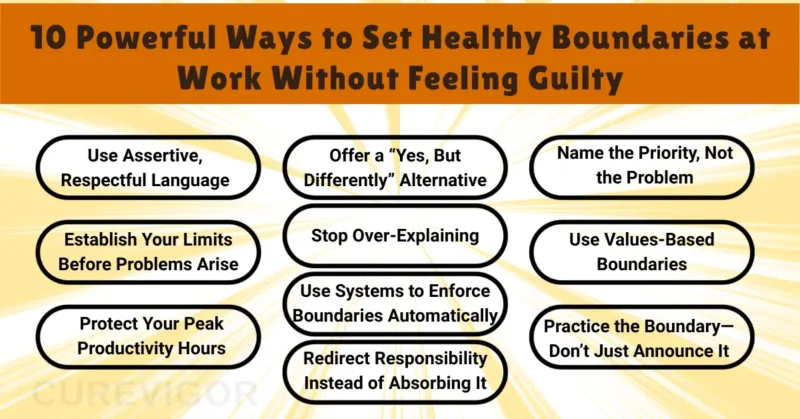
Each strategy blends real-world practicality with leadership psychology. These aren’t just communication tricks—these are authority-building habits that reshape how people perceive and interact with you.
1. Use Assertive, Respectful Language (No Apologies Needed)
Assertiveness is not aggression—it’s clarity with kindness. When you speak without unnecessary apologies, you signal that your time is valuable and that your decisions are intentional.
Most over-givers apologize before they even decline a request. But leaders use brief, steady language that respects both sides.
Stronger Example:
“I’m unavailable for additional tasks today, but I can revisit this first thing tomorrow.”
Notice the tone: direct, neutral, and confident. No guilt, no over-explaining, no emotional weight. This sets a tone of professional self-respect that others naturally respond to.
2. Establish Your Limits Before Problems Arise
The strongest boundaries are proactive, not reactive. When you outline expectations early, you eliminate confusion, prevent scope creep, and create predictable rhythms at work.
Examples include:
- Setting meeting hours that match your focus patterns
- Clarifying communication channels (email vs. instant messages)
- Blocking deep-work time on your public calendar
- Outlining project turnaround times or workflow rules
These signals show that you operate with structure—something high-performing teams value deeply. People adapt quickly when they know what to expect.
3. Protect Your Peak Productivity Hours
Every high achiever has hours when their brain is sharper, faster, more creative, or more strategic.
Without boundaries, these hours get stolen by small tasks, interruptions, and urgent-but-not-important requests.
A visible “focus” signal helps others respect your cognitive bandwidth:
- A desk sign that indicates deep work
- A calendar block marked “Unavailable—Focus.”
- A Slack/Teams status that shows your work mode
- A closed-door policy during certain hours
When you protect your highest-value thinking time, your performance improves—and so does the quality of your leadership.
4. Offer a “Yes, But Differently” Alternative to Set Boundaries
Boundaries don’t always require a hard “no.” Sometimes the most effective limit is a reframed “yes” that aligns with your time and capacity.
Example:
“I can’t join the full meeting, but send me the minutes and I’ll review them today.”
This approach reduces time drain while still contributing meaningfully. You remain a team player, but not at your own expense.
5. Stop Over-Explaining—Short Answers Are Strong Answers
When you over-explain, you unintentionally invite negotiation or guilt. Short sentences communicate confidence and eliminate loopholes.
Effective Example:
“I don’t have the capacity for that today.”
Short, steady, and complete.
Not: “I’m sorry, I have so much on my plate, maybe if I finish early, I could try…”
Over-explaining makes you look unsure. Brief answers demonstrate certainty.
6. Use Systems to Enforce Set Boundaries Automatically
Boundaries collapse when you rely on willpower alone. Systems create consistency.
Examples:
- Email auto-responses during high-demand periods
- Calendar blocks that prevent double-booking
- Task queues that organize requests
- Designated communication channels instead of constant interruptions
Systems communicate your availability without emotional labor. People adjust because the system reinforces their limits for them.
7. Redirect Responsibility Instead of Absorbing It
Many high achievers unintentionally rescue others by solving problems that aren’t theirs. This creates dependency and overload.
A powerful leadership tactic is to return responsibility—respectfully.
Example:
“What solutions have you considered so far?”
This encourages ownership, strengthens your team’s competence, and prevents the “default problem-solver” trap.
You’re not withholding support—you’re empowering growth.
8. Name the Priority, Not the Problem
When leadership hands you something at the last minute, you can respond strategically without coming across as unavailable or resistant.
Example:
“I can take this on, but I’ll need your direction on what should move down the priority list.”
This approach:
- Respects the request
- Acknowledges reality
- Puts responsibility for prioritization back where it belongs
- Shows maturity and strategic thinking
You avoid overload without saying “no.”
9. Use Values-Based Set Boundaries
Guilt fades when you set boundaries that are anchored in your core values. Values add weight, clarity, and purpose to your decisions.
Examples of values-driven boundaries:
- “I protect my evenings for my family.”
- “My deep-focus time is essential for high-quality work.”
- “I commit to timelines I can realistically meet.”
When your boundary exists to honor a value, it becomes a principle—not a preference.
People respect principled limits more than reactive ones.
10. Practice the Boundary—Don’t Just Announce It
Most boundaries fail because they’re inconsistently enforced. The real power lies in disciplined repetition.
Every time you reinforce your boundary calmly and consistently, you teach others how to interact with you. Repetition builds familiarity, and familiarity builds respect.
Your pattern becomes your reputation.
How to Manage Guilt (The Emotion That Keeps You Trapped)
Guilt shows up because:
- You’re used to being the helper.
- You’re not used to prioritizing yourself.
- You fear disappointing others.
But here’s the truth:
Guilt is a signal, not a command.
You can feel it—and still hold your boundary.
A powerful reframe:
Saying no to one thing allows you to say yes to the right thing.
How Boundaries Strengthen Leadership
Leaders who confidently set boundaries:
- Earn deeper respect
- Avoid burnout
- Model balanced behavior
- Empower their teams
- Improve productivity
- Build trust through consistency.
Good boundaries = better performance.
Good boundaries = better teams.
Good boundaries = better well-being.
The Boundary Success Cycle
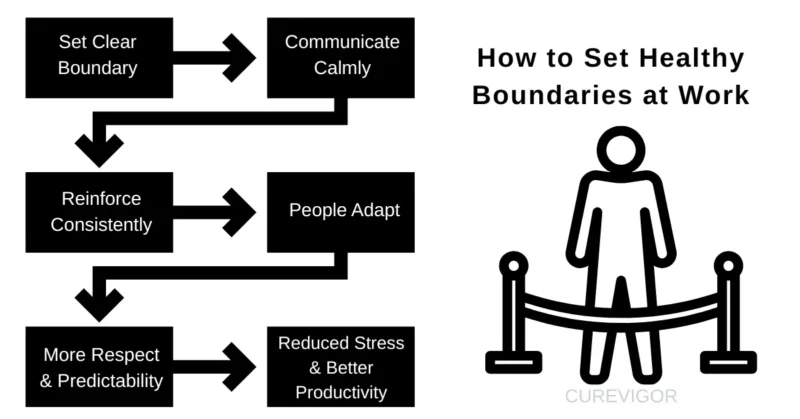
The Bottom Line on How to Set Boundaries
When you set boundaries, you don’t limit your potential—you unlock it. Clear limits free your time, sharpen your focus, and strengthen your leadership presence.
The more confidently you protect your energy, the more effectively you show up for the work that truly matters. Setting boundaries isn’t a barrier; it’s a catalyst for sustainable success.
Ready to reclaim your time, energy, and confidence? Start setting healthy boundaries today—your peace and productivity are worth protecting. Take the first step now.
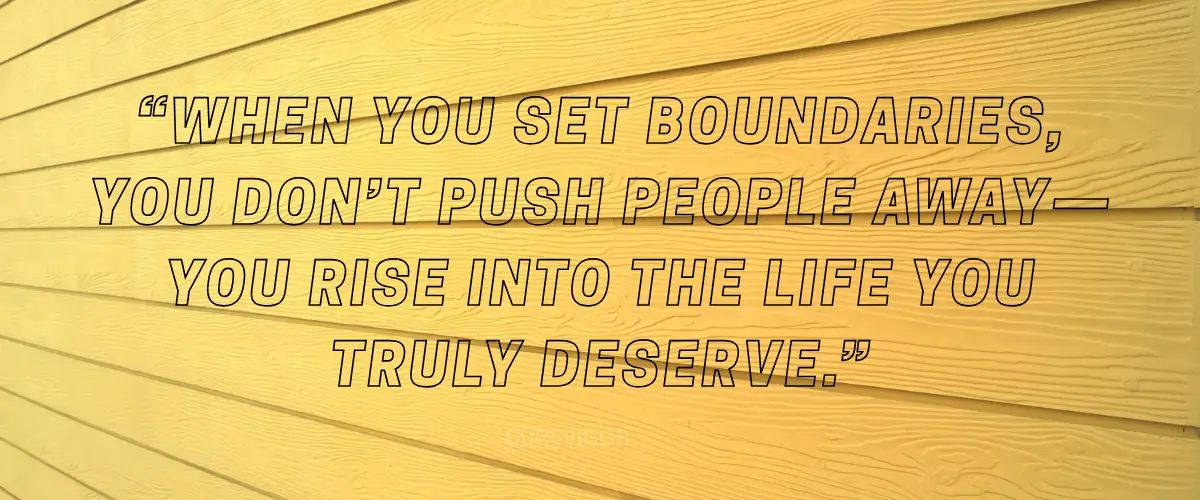
Read more Health and Life Balance articles.
You might like:


